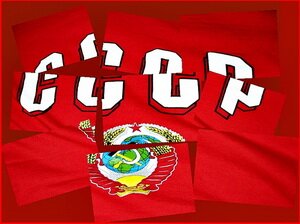
The collapse of the Soviet Union in 1991 was followed by a series of armed conflicts. Some are still blazing with varying intensity from western to south-eastern borders of the former Soviet Union. In particular, areas of conflict are considered Trans-Dniester, Abkhazia, South Ossetia, Nagorny Karabakh, and Tajikistan, where confrontation between different parties of the conflict escalated into fighting actions of high intensity.
All this is a consequence of sharpening of historical problems of national and religious nature against the background of destructive processes of the former Soviet Union, targeted provocative actions of the Soviet, and later Russian intelligence services, trying to keep the ex-Soviet territories under Russia’s control. By the way, a characteristic pattern: every single conflict in the former Soviet Union is taking place in areas of deployment of military units of the Soviet army.
Ukraine in this aspect was lucky; wars and armed conflicts of the early 1990s did not affect it. Though in 1993-1994 in the southern regions of Ukraine, especially in the Crimea, it was very close to an armed confrontation with the great empire Russian tinge. The Black Sea Fleet nearly played the major role in this, as the main striking force of the Russian Federation at the territory of Ukraine.
Even today, despite all the assurances of the Russian side, it is a threat to national security of Ukraine. Therefore all the momentous occurring events in the Crimea in the first half of the 1990s remain and will continue to be relevant.
The Beginning of the "Great Way”.
With increased centrifugal processes in the former Soviet Union, a question of the future of the Soviet Army had got especially sharp. Quite naturally, the process of solving this question affected also the fate of the Black Sea Fleet, automatically having made it a hostage of political solitaires of some Moscow neo-imperialists. Russian authorities insisted that the armed forces were common under the sole Russian commandment, and military reforms focused only on removing conservative-minded groups of commanders, liquidation of political agencies, the overall reduction of the number of personnel and some structural changes.
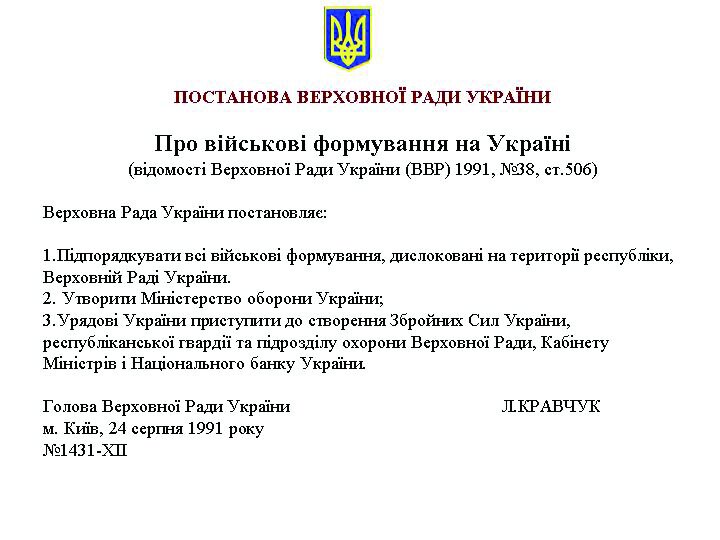
|
| Resolution of the Verkhovna Rada of Ukraine "On the military formations in Ukraine" |
However, a few weeks after the "August Coup", some of the former Soviet Union states, particularly Ukraine, Azerbaijan and Moldova, decided to create their own national armies. And, the most principled position in this regard was that of Ukraine. Already on the 22nd of October, 1991, Verkhovna Rada of Ukraine adopted in first reading a set of laws on the Armed Forces. According to these laws, Ground Forces, Navy and Air Forces had to be established. The Border Troops and Republican (later called National) Guard were also to be formed.
Ukrainian leadership's desire to create their own armed forces resulted from the political goals of turning Ukraine into a truly independent and powerful, economically developed country.
Such intentions of Ukraine and some other republics as to the Soviet army, did not suit the Russian Federation’s leaders, who were trying to automatically control the whole post-Soviet territories through their monopoly control over the military forces. Aiming at this, Russia put forward an alternative idea of “joint” armed forces. On the 28th of October, 1991, President of RF Boris Yeltsin announced that “it is politically justified to have joint forces of the CIS under the sole control”. At this, there were determined the ways of their creation, in particular:
- preservation, under the centralized control, of unified strategic deterrent forces, including nuclear forces, as well as an early warning system, missile defense, space exploration, etc.
- formation at the basis of the national armed forces, not including the strategic components of the Joint Armed Forces of the CIS within the framework of the same strategic space with a single operational and strategic plan, a unified system of training of the staff and control of the troops.
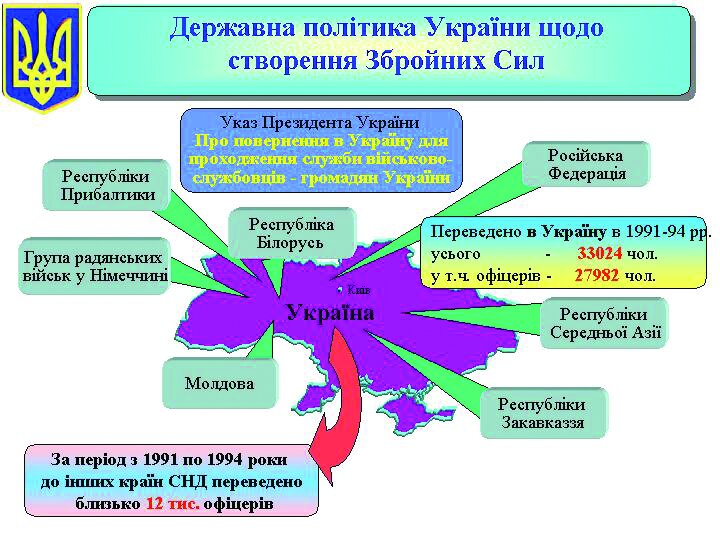
|
|
State policy of Ukraine as to foundation of the Armed Forces http://www.mil.gov.ua/ |
According to the military-political leadership of Russia, such a scheme, recognizing de jure the right of sovereign states to form their own armies, could be the basis for the favorable for Russia compromise in case, if all the CIS countries, and especially, Ukraine, showed their political will to seek it.
At the same time, the premise of a unified command and control system and a sole operational and strategic plan, which is embedded in the concept of a "sole" or "common" military-strategic space, actually brought down the idea of "joint armed forces" to some expansion of participation of new leaders of sovereign states in the decision-making on military matters, while maintaining the sole military structure, controlled by Moscow.
In November 1991, the problem of the armed forces goes to the highest political level. Its principle solving was supposed to be determined in the process of preparation of a new union agreement. But, after signing on December 8, 1991, in the Belovezhskaya Pushcha the Agreement on Liquidation of the USSR, the process of the division of the Soviet Army becomes a separate political event. The Agreement on the Establishment of the CIS suggested preservation and retention of a common military-strategic space under a sole commandment. In general it suited the intentions of the Ministry of Defense of the now ex-USSR.
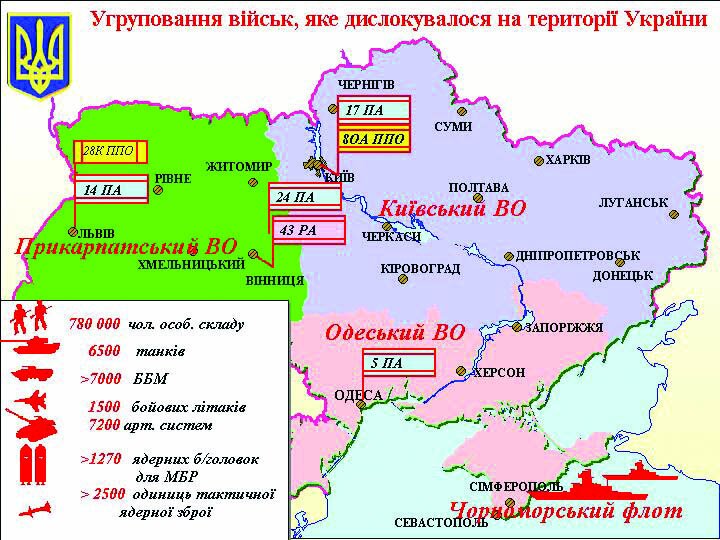 |
|
Grouping of troops stationed in Ukraine http://www.mil.gov.ua/ |
At the same time, based on the principles of the "Declaration of State Sovereignty" during its ratification, Verkhovna Rada of Ukraine made its principal amendments. In particular, the following wording appeared in the document, "Member states of the Commonwealth of reform based on their territory units of the armed forces of the former USSR, and creating at their base their own armed forces, will cooperate in maintaining international peace and security."
On the 12th of December, 1991, the President of Ukraine L.Kravchuk signed the Decree on Entrusting on himself the Duties of the Chief of the Armed Forces of Ukraine, which had to be formed on the basis of the Kiev, Odessa and Carpathian military districts, and the Black Sea Fleet. At this, according to the statement of L.Kravchuk, Ukraine provided interaction and coordination of all its decisions in the field of military construction with other countries of the Commonwealth and the USSR Ministry of Defense, at that time still not liquidated. The number of Ukrainian Armed Forces was to be determined only after the USSR Ministry of Defense specifically determines which components of the troops at the territory of Ukraine belonged to the strategic forces, and which — to non-strategic.
In principle, the problem of the nuclear weapon was solved. The Declaration, signed on the 21st of December, 1991 in Alma-Ata, suggested that a sole control over nuclear weapons remains, Ukraine joins the Treaty on the Non-Proliferation of Nuclear Weapons and by the 1st of July, 1992 will have moved to Russian territory tactical nuclear weapons, and in the future will liquidate strategic nuclear weapons too.
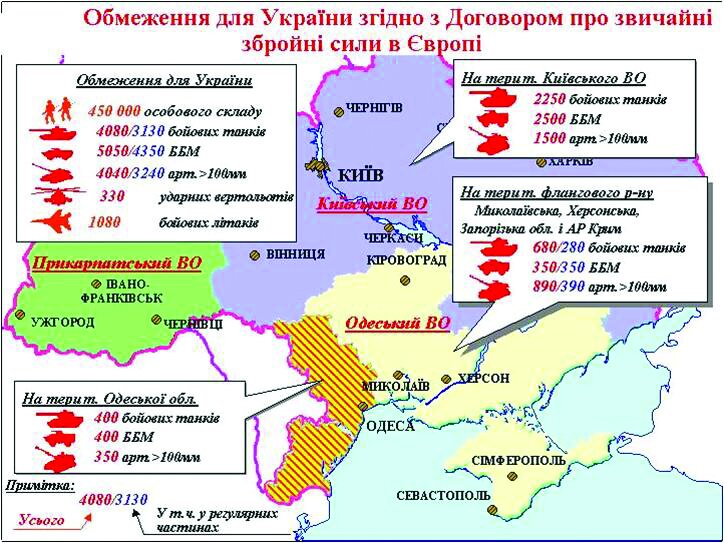
|
|
Limitations for Ukraine in accordance with the Agreement on Conventional Armed Forces in Europe http://www.mil.gov.ua/ |
At the time, Russian leaders did agree with such a decision. Taking into account the moderate position of Ukraine, Ministry of Defense of the former USSR developed such principles for reforming of the armed forces which allegedly provided for the right of independent states to create their own national armies, but in fact was limiting them to purely symbolic national contingents, while the backbone of the army would remain under a sole Russian commandment. At this, the process of creation of national armies had to be "on the basis of mutual agreements," which inevitably stretched it over time. These principles were proposed by the Minsk Meeting of CIS Defense Ministers on December 30, 1991, but were declined by Ukraine, Azerbaijan and Moldova, as contradicting their national interests. Ukraine demanded the transfer of troops directly under the control of the countries which declared about the creation of their own armed forces.
* * *
In response to the actions of the Ukrainian leadership, Russia's leaders declared that the Black Sea Fleet, stationed mainly in Ukraine, was Russian. Taking into consideration the importance of B. Yeltsin was taking his personal decision. On the 27th of January, 1992, the President of the Russian Federation arrived in Novorossiysk, where at that time there was one of the largest Black Sea Fleet’s ships – helicopter-carrier "Moscow". On board this ship B. Yeltsin met with the commandment of the Black Sea Fleet and set tasks according to the current political situation.
Firstly, the Black Sea Fleet of the former Soviet Union under any circumstances had to remain only in the Russian command. Secondly, it had to fulfill the function of absolute support to pro-Russian movements in the Crimea, using armed force included.
More so, from the Russian Black Sea Fleet most modern ships were excluded and promptly sent to other Russian fleets. In particular, to the Northern Fleet immediately were sent the aircraft carrier "Admiral Kuznetsov" and several newest warships.
At the same time to the troops, including those that were located outside of Russia goes a coded telegram on taking the oath of allegiance to the Russian Federation. The Decree on the Transfer of All the Armed Forces of ex-USSR under the Jurisdiction of Russia was also considered.
Such a decision could provoke a serious conflict, because at that time, due to targeted personnel policy of the USSR Ministry of Defense, in the officer corps stationed in Ukraine, Ukrainians made up less than 30%.
The severity of the situation was somewhat lower at the end of January 1992, when Russia and Ukraine promised not to take unilateral actions. An agreement was reached on the Black Sea Fleet, within the framework of which ships with nuclear weapons were passed over to the CIS, and the rest – to Ukraine. However, many questions, concerning the classification of ships, their basing, etc, remained.
* * *
At the same time, Russian-Ukrainian contradictions were not brought up only to the Navy or other components of the armed forces. These contradictions reflected the profound geopolitical confrontation, explained by the appearance in the south-western part of the former Soviet Union of a powerful military and economic state that could become a regional center of forces and control a large part of the sea and terrestrial RF communications, which did not coincide with its geopolitical goals.
In order to remove this threat to its interests, the Russian government decided to use the Crimean Peninsula as a permanent instrument of pressure on Ukraine. At the first stage, the main "battering ram" of chauvinists was the Communist Party of the Crimea.
Thus, even before the collapse of the USSR in the Crimean Republican Committee of the CPSU, there were about 160,000 communists. It had always been a most conservative part of the Communist Party, since almost half of its members consisted of retirees from the Army, Navy, KGB, political bodies – and so-called Soviet party nomenclature. They perceived with particular caution the process of democratization of Ukraine in the late 1980s, and opposed any democratic changes in the peninsula. Particularly they could not stand the national-democratic rebirth of Ukraine. It was not without reason that the idea of the Crimean autonomy was born in the depth of the Crimean Communist Party Committee. Its implementation was supposed to help them dissociate themselves from the processes taking place in Ukraine. According to the leader of Crimean communists L. Grach, this idea was first approved in 1988 at a Conference of the Crimean Republican Committee. But its realization was impossible without a resolution of the Verkhovna Rada of Ukraine. In order to realize it, the leaders of the Crimean communists made a sort of a plot with the communist majority in the supreme legislative body of the Republic (Group 239).
At this, the autonomy they associated with the proposal of forming a strong base in the Crimea to support the Communist Party, which at the time had already lost its influence in most of the regions of Ukraine. It is due to this fact, the Crimean communists made the Verkhovna Rada of Ukraine to adopt a resolution on the establishment of the Crimean Soviet Autonomous republic within Ukraine. At this, the Crimean Regional Council was converted to the Supreme Council and the Autonomy, and contrary to the laws of Ukraine, its members without elections delegated deputies of Sevastopol City Council to it. All this allowed the Crimean separatists to limit the powers of the Ukrainian state institutions and mass media in the peninsula, and to create favorable conditions for the activity of anti-Ukrainian forces.
* * *
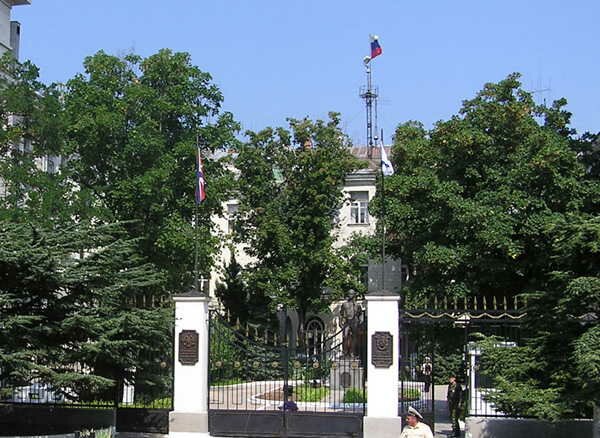 |
| Headquarters of the Black Sea Fleet. The left wing houses the Intelligence http://nomos.com.ua/content/view/226/76/ |
The processes of exclusion of the Crimea from Ukraine were immediately joined by the structures of the former KGB, GRU (Intelligence Service), and the Black Sea Fleet and its intelligence units. It was in the Crimea that the most favorable conditions for the work of the Russian special services had been formed. This region is the only place outside of Russia, where the GRU had been able to operate openly and legally, on the basis of intelligence structures of the Black Sea Fleet, which was in double subordinate to Russia and to Ukraine. After activation of separatist processes in the Crimea, at the time of the overall reduction of the fleet, the military intelligence structures got expanded and strengthened, in particular through the deployment of maritime intelligence center in Novorossiysk, into responsibility of which, apart from Georgia, Turkey and Romania, Ukraine was also included. In accordance with the order of the Intelligence Chief of the BSF, this center gets data on the military intelligence agents in the Crimea, Odessa and Nikolayev, which leads to a paradoxical situation in which the agents in Ukraine tried to lead the intelligence agencies of Russia.
In general, the work of the Russian special services in the Crimea was made much easier by the presence of agents of the central apparatus of the KGB, which was specific to the region (the presence of a large number of party and state dachas, sanatoria, recreations, etc.), did not obey and was not known to local state security bodies, passed under the jurisdiction of Ukraine.
The main goals of such agent network were gathering information and a special propaganda. In particular, since the beginning of the division of the Black Sea Fleet, into the staff of some newspapers published in the Crimea, were introduced special officers of the propaganda department of GRU. Soon the pages of those newspapers were full of openly anti-Ukrainian publications.
One of the indirect signs of the GRU’s work in Ukraine was the opening of a field office of the Russian State Bank in Sebastopol, conducting all the financial transactions directly with Russia, bypassing the Ukrainian banking system. Transactions with large sums of money were carried out without any control. In this case, Russia justified the opening of the office by need in operative funding of the Fleet. In reality, these offices did not just carry out financial expansion into Ukraine, but financed the intelligence activities, supported the pro-Russian candidates during the election campaigns, "bought" politicians, etc.
GRU was totally monitoring all objects of the Armed Forces, the Ministry of Inner Affairs and the National Guard of Ukraine, located in the territory of the autonomous republic. Moreover, there had been violent detentions of Ukrainian soldiers by Russian secret services, from whom members of the GRU and FSB requested information on the staff, status and activities of units of the Armed Forces of Ukraine.
Agents were trained for work in the Crimea at special schools at the territory of Russia. In particular, near Voronezh in one of these specially opened specialized schools, several groups, meant for further infiltration into the Crimea, were trained.
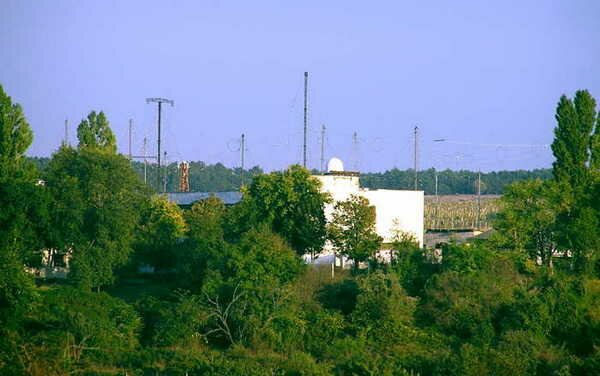 |
| A radio group can easily be identified by a specific lace of antennas http://nomos.com.ua/content/view/226/76/ |
Apart from purely covert methods of monitoring the southern regions of Ukraine, were also used electronic surveillance, namely the 130th center REI, 3rd Reconnaissance radio group and 112th Brigade of reconnaissance ships of the Black Sea Fleet.
Along with providing special operations, the commandment and servicemen of the Black Sea Fleet were more and more involved in the immediate political struggle for the separation of the Crimea from Ukraine. This struggle had been coordinated by the then Commander-in-Chief of the Russian Navy Admiral of the Fleet V.Chernavin. Trying to transfer the artificially created problem of the division of the BSF from strictly technical to the political plane, V.Chernavin repeatedly met with seamen — Russian MPs, pushing them to the initiation of this issue to the Supreme Council of Russia. Moreover, not content with the role of "bystander watching the death of the Black Sea Fleet," V.Chernavin personally arrived in Sevastopol, where he started to "bomb" the Russian President Boris Yeltsin and Defense Minister V.Shaposhnikov with desperate telegrams demanding to speed up the process of taking the BSF under Russian jurisdiction.
Aiming at political strife in the Crimea and Sevastopol, Navy Commander’s actions were supported by the Commander of the Black Sea Fleet Admiral I.Kasatonov. Making the choice between Ukraine and Russia in early 1992, hesitating and doubting in the correctness of the upcoming step, Admiral suddenly switched to Moscow's side when he had been promised a future appointment to the post of the Chief Commander of the Russian Navy. In Sevastopol, with the support of I.Kasatonov, along with the organization of material and moral support to anti-Ukrainian movements and parties that had been founded began a violent campaign of harassment of officers and warrant officers who expressed a desire to take the oath of allegiance to the people of Ukraine and to go to its Navy. For them, unbearable conditions for the service were created; they were accused of serious breaches of military discipline, which gave the Chief Commander the formal grounds to dismiss them for "discrediting the officer’s rank”.
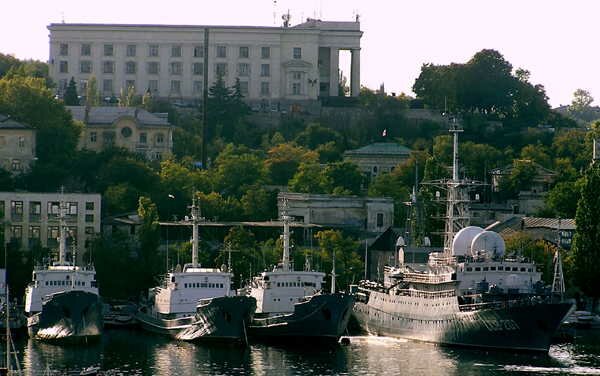 |
| At first glance, intelligence ships can be confused with peaceful hydrographs http://nomos.com.ua/content/view/226/76/ |
In order to give the appearance of supporting the anti-Ukrainian actions of Russia by the local population, the FSB and the Black Sea Fleet military intelligence agents quickly formed puppet organizations of the Russian-chauvinist orientation, to which they managed to attract mainly aged people. To finance their activities, commercial organizations of dubious origin were giving significant amounts of money, often obtained through criminal scams (as was the case with the infamous company "Impex-55").
The chauvinistic unit included several parties and movements, such as "Russian-Speaking Crimea Movement", "Russian Community of the Crimea"(leader A.Los), "Russian Party of the Crimea" (leader S.Shuvaynikov), "National Salvation Front" (leader O.Kruglov) and "All- Crimean Movement of Voters for the Republic of the Crimea."
The largest organization of this unit was the "Republican Movement of the Crimea" (URP), whose leaders were Yu.Meshkov, S.Tsekov and V.Mordashov. Activity (URP) was financed by the above mentioned commercial enterprise "Impex-55", which in the years of absolute power of the Communist Party of Ukraine – the CPSU, had received millions of dollars of interest-free loans from the State Bank of Ukraine, and later – from commercial structures of Russia, so, in fact, it served as the Financial pump or an intermediary in the financial support of anti-Ukrainian demarches in the Crimea.
In February 1992, thanks to the help of the commandment of the Black Sea Fleet, managed by the chauvinistic circles of the RF, URP began collecting signatures for a referendum, “For the Independent Republic of the Crimea, in alliance with Other States of the Former Soviet Union." As a result, by April URP had gathered about 247,000 signatures of citizens of the Crimean Peninsula.
Based on the so-called "Social support", President Boris Yeltsin signed a Decree on the Status of the Russian Black Sea Fleet, by which "...in order to support the sustainable management of the Black Sea Fleet, maintaining its combat readiness, as well as social protection of servicemen and their families," as well as "...Taking into account the historical traditions of the Fleet, and in connection with the uncertainty of the status of the BSF" ordered:
- "to put the Black Sea Fleet under the jurisdiction of the Russian Federation with the subordination of its allied commandment to the Chief Commander of the Joined Armed Forces of the CIS;
- to determine that financing of the activity of the Black Sea Fleet should be done at the expense of the budget of the Russian Federation."
* * *
Naturally, the incitement of political strife in the Crimea, and the involvement of the Navy in dirty political games of chauvinists against Ukraine, did disturb the majority of the population of the peninsula and the Black Sea Fleet sailors.
To protect their interests, concerned citizens were creating various forms of associations, in order to oppose the attempts to destabilize the situation on the peninsula.
Such a centrist bloc of parties and movements included: "The Federation of Independent Trade Unions of the Crimea", "The Union of entrepreneurs of the Crimea" (leader S.Kunitsyn), "The Party of Economic Revival of the Crimea" (PEVK), "Democratic Party of the Crimea" (leader S.Filatov) .
The Crimean bloc of center-right and national-democratic organizations was represented mainly by Ukrainian and Crimean Tatar political organizations. These were the Crimean Regional Organization of the Ukrainian Republican Party (URP) and its sister- party of Ukrainian Civic Congress of the Crimea, which together had about four thousand members and had an extensive network of local organizations. The Crimean organization "Prosvita" and the People's Movement of Ukraine also functioned in the Crimea at that time.
However, the Ukrainian national-democratic organizations of the Crimea had to operate in extremely difficult conditions. URPS, UCCC, «Prosvita» not only were constantly opposed by the local authorities. Often they did not have material resources to support their activities. They were in a strange, at first glance, situation: to the local separatist-minded government they were strangers, to communists and Russian chauvinists they seemed just hostile. And even to the official Kiev, where in the government offices pro-communist-minded officials entrenched, they also found themselves in the role of outsiders.
In order to break this vicious circle, to support the Ukrainian organizations of the Crimea and to strengthen the processes of national and cultural renaissance, the Committee of Public Organizations "Crimea with Ukraine" was created in the peninsula. The committee included representatives of the URP, DemPU, "Prosvita" and PMU. The committee’s activity was directed to provide organizational and technical assistance to Ukrainian organizations, the spread of Ukrainian newspapers, books, magazines, and local Ukrainian press, new Ukrainian educational, cultural organizations, aiming at reviving Ukrainian schools, language and culture.
In a short time they managed to initiate the creation of an organization of scientists, "Crimea with Ukraine", whose appeal to the residents of the Crimea had been signed by more than one hundred scientists, members of the Association of Ukrainian Education Workers in the Crimea, people from the Society of the Repressed. The Committee held the first and the second congresses of deputies of all levels of the Crimea "For Peace and National Reconciliation", which brought together more than 300 people. Congresses of deputies, speeches of deputies were broadcast on radio and television, which greatly influenced the political situation in the Crimea, giving hope for a better future to hearts of the Crimean Ukrainians.
The activity of the Committee "Crimea with Ukraine" - "Collegiality" Crimean organization of URP helped organize and conduct in August 1992, the first All Society Congress of Ukrainians, which was attended by over a thousand delegates, and which had become a significant event in the life of Ukrainians of the Peninsula. A great help in carrying it out gave the President of the "Crimea-Continental" concern Yu.Kolesnikov, elected the first Chairman of the Congress.
In order to withstand the flow of misinformation of Russian Media, the " Crimea with Ukraine" Committee published and distributed among the population of the Crimea millions of newspapers, magazines and leaflets. More than 15,000 Ukrainian books of military and patriotic themes were received by Ukrainian military units and Ukrainian Navy. The Committee established the first Ukrainian newspaper on the Peninsula "Crimean Bulletin" and proceeded to publishing its press bulletin.
The activity of the Ukrainian organizations, the revival of Ukrainianism in the Crimea pulled the trump card from the hands of the separatist forces, stubbornly trying to make it look like "...there are no Ukrainians in the Crimea, there is only Russian-speaking population there “.
To counteract the separatist decisions of the Supreme Council of the Autonomy there was established the Public Council of the Crimea (opposition Parliament), made up of delegates from a number of pro-Ukrainian political organizations and parties, namely UCCC, URP, DemPU, DemKrym and Majlis of the Crimean Tatars.
Leonid Kravchuk’s Presidential Decree ( March 1992) also helped strengthen Ukraine’s positions in the Crimea. According to Article 77 of the Constitution of Ukraine it confirmed the republican (Ukrainian) status of Sevastopol. L.Kravchuk’s another Decree -"On Urgent Measures for Building the Armed Forces of Ukraine" suggested to begin, on the basis of the Black Sea Fleet (in coordination with the Chief Commandment of Allied CIS Armed Forces), forming the commandment bodies of the Ukrainian Navy. Simultaneously, the Verkhovna Rada of Ukraine adopted the Law "On the Division of Powers between Ukraine and the Republic of the Crimea", which laid down the status of the Republic of the Crimea as a part of Ukraine.

